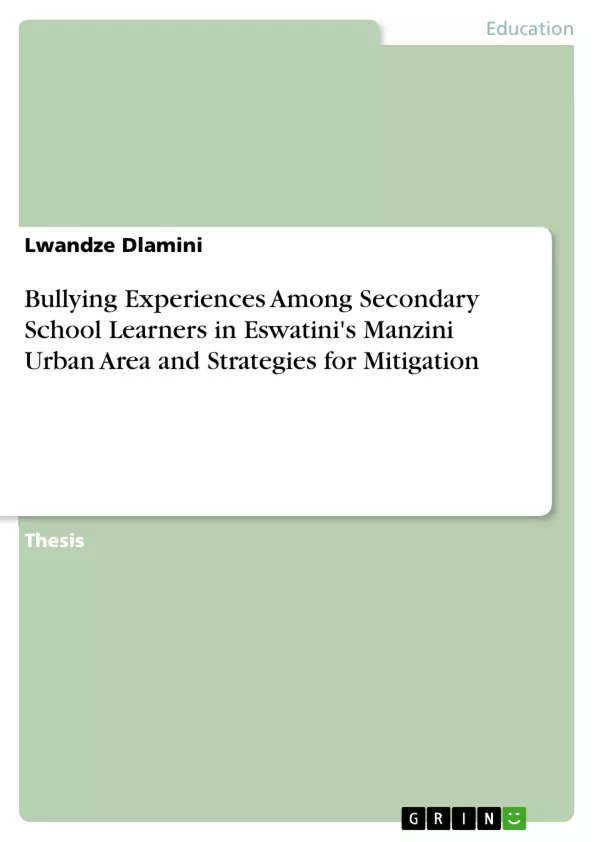Bullying is one of the major issues educators, learners and school communities are facing in Eswatini, Africa, and globally. This study looks at secondary school learners' experiences of bullying in co-educational schools in the Manzini urban area.
The main objectives of the study are to identify forms or types of bullying experienced by learners, effects of bullying in the lives of learners, characteristics of the victims of bullying, as well as strategies which can be adopted to counter bullying in the school context. The study uses a qualitative research approach where thirty individual interviews were conducted with form 2, 3 and 5 learners, including three guidance teachers. Data is analysed through themes. A detailed analysis of the themes is then conducted to tell a coherent and a persuasive account on the experiences of bullying.
The study found that boys usually engage in physical forms of bullying, such as hitting, punching and kicking, while girls often engage in verbal forms of bullying such as hurling insults, name-calling, spreading rumours, as well as cyberbullying. These forms of bullying affect learners socially, emotionally and psychologically, including their academic performance. Gender identity, age, and economic status were found to be the common characteristics among victims of bullying. Socialization also seems to play a major role in perpetuating bullying in schools, as boys exercise their power over those whom they deem to be weak. The study recommends that various stakeholders such as teachers, parents, non-governmental organizations and social workers could work together to minimize the prevalence of bullying in schools.
Inhaltsverzeichnis (Table of Contents)
- CHAPTER 1: INTRODUCTION
- 1.0 Introduction
- 1.1 The Background
- 1.1.1 Global status of bullying
- 1.1.2 Causes of bullying
- 1.1.3 Common types of bullying
- 1.1.4 Effects of bullying on learners
- 1.2 Statement of the problem
- 1.3 Aim/purpose of the study
- 1.4 Objectives
- 1.5 Research questions
- 1.6 Assumptions of the study
- 1.7 Significance of the study
- 1.8 Limitations of the study
- 1.9 Delimitations of the study
- CHAPTER 2 LITERATURE REVIEW
- 2.0 Introduction
- 2.1 Ecological Systems Theory
- 2.1.1 Microsystem
- 2.1.2 Mesosystem
- 2.1.3 Exosystems
- 2.1.4 Macrosystem
- 2.1.5 Chronosystem
- 2.1.6 Justification of Ecological Systems Theory
- 2.2 Empirical Studies
- 2.2.1 Different types of bullying
- 2.2.2 Effects of bullying
- 2.2.3 Interventions for helping bullied pupils
- 2.2.4 Characteristics of learners who experience bullying
- CHAPTER 3: RESEARCH METHODOLOGY
- 3.0 Introduction
- 3.1 Research approach
- 3.2 Area of study
- 3.3 Research design
- 3.4 Population
- 3.5 Sampling technique
- 3.6 Method of data collection
- 3.7 Issues of trustworthiness
- 3.7.1 Validity of interview question guide
- 3.8 Data analysis and presentation
- 3.9 Research Ethics
- CHAPTER 4: DATA ANALYSIS AND DISCUSSION OF FINDINGS
- 4.1 Introduction
- 4.2 The different types of bullying experienced by secondary school learners
- 4.3 Effects of bullying experienced by secondary school learners
- 4.3.1 Social effects
- 4.3.2 Academic effects
Zielsetzung und Themenschwerpunkte (Objectives and Key Themes)
This research study explores the experiences of bullying among secondary school learners in the Manzini urban area of Eswatini. The main aim of this study is to investigate the forms of bullying experienced by learners, the effects of bullying on their lives, the characteristics of victims, and potential strategies to address bullying in the school context.
- Types of bullying experienced by learners
- Effects of bullying on learners' social, emotional, and academic well-being
- Characteristics of victims of bullying
- Strategies to counter bullying in the school environment
- Role of socialization and power dynamics in perpetuating bullying
Zusammenfassung der Kapitel (Chapter Summaries)
Chapter 1 introduces the study, providing a background on bullying globally and exploring its causes and effects. The research problem, aims, objectives, and significance are outlined, along with limitations and delimitations. Chapter 2 delves into the literature review, focusing on the Ecological Systems Theory and its application to understand bullying. The chapter also examines empirical studies on various types of bullying, its effects, interventions, and characteristics of victims. Chapter 3 outlines the research methodology used in the study, including the qualitative approach, area of study, research design, population, sampling technique, data collection methods, and data analysis procedures. The chapter also discusses ethical considerations. Chapter 4 presents the analysis of the collected data, exploring the different types of bullying experienced by learners, the effects of bullying, and the characteristics of victims. This chapter focuses on the social, emotional, and academic impacts of bullying, providing insights into the complexities of this issue in the secondary school context.
Schlüsselwörter (Keywords)
Bullying, secondary school learners, Manzini urban area, Eswatini, qualitative research, forms of bullying, effects of bullying, victim characteristics, interventions, social effects, academic effects, power dynamics, socialization.
- Quote paper
- Lwandze Dlamini (Author), 2021, Bullying Experiences Among Secondary School Learners in Eswatini's Manzini Urban Area and Strategies for Mitigation, Munich, GRIN Verlag, https://www.grin.com/document/1436083



